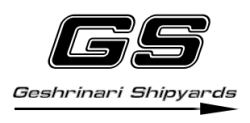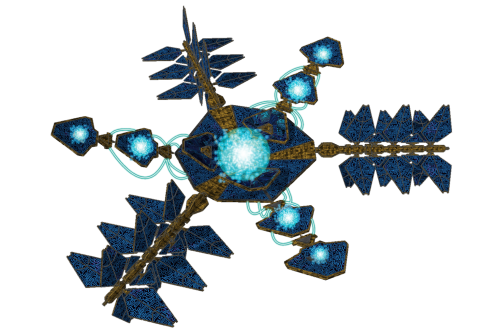Sidebar
Table of Contents
Ge-H1-E3301 - Standard Station Sensors
The Ge-H1-E3301 was first developed for use on the Ge-H1-7A - Kōdaina Minato-Class Orbital Installation. It became available in YE 33.
About
This sensor package was developed to provide a wide range of detection types for fixed and mobile space installations. It is a modular design, and typically multiple units are utilized concurrently on each station to provide the full range of coverage.
Specifications
General
Class: Ge-H1-E3301 Type: Sensors Designers: Geshrinari Shipyards Manufacturer: Geshrinari Shipyards
The Ge-H1-E3301 provides the following capabilities:
Long Range Sensors
Passive Omni-directional Sensors
Imaging Array
- Long range telescope (50 LY)
- Variable wide-band imaging clusters
- Long-range gravimetric and magnetic resonance, distortion, and interferometry sensors and spectrometers
- Electromagnetic trans-space flux sensors and imaging scanners
- Quark and gluon density scanners, and spin polarometers.
Unidirectional Sensors
Include variable wide-band imaging clusters, long-range gravimetric and magnetic resonance and distortion sensors and spectrometers. Most of these sensors have a range up to five light-years.
Subspace Mass Detector
Subspace mass sensors instantly detect mass readings and movement of objects. The readings are used both for early warning and navigation when traveling at sub-light speeds. The readings are not very detailed and cannot detect objects of less than 60,000 kg.
- Range of 20 LY
- Faster than light
- Good for finding large ships or fleets of ships.
- Cannot identify types of objects.
Mixed Sensor Array
- Electromagnetic sensors
- Electrogravitic sensors (scalar)
- Unified field mass/energy sensors
- Neutrino sensors
- Tachyon sensors (faster than light)
- Tachyon Scanners detect the disturbances in the gravitic characteristics of normal space caused by the passage of ships traveling through hyperspace. Tachyon scanners also reduce the effectiveness of enemy missile jamming systems.
- Range of 1 LY
Short Range Sensors
Life Detection Sensor
This sensor allows the station to detect and identify various life forms within range. This sensor has different functions and ranges.
- Basic - provides the most basic scan detecting that life forms are present. Range: 25 km omnidirectional
- Filtered - allows the operator to filter out life forms based on class from simple organisms to more complex. This mode will actually attempt identify the life forms present, by comparing the signatures to known values. Range: 50 km omnidirectional.
- Advanced - increases the range of the scanner by selecting a specific type/class of life form for the scanner to search for. Range: 500km directional only.
Freight Scanner
Similar in part to the life detection sensor, this device allows the station to detect and identify certain kinds of technology and items – it is mostly used to track down Smuggling of weapons and other prohibited items. However, it is possible to block this kind of sensor using certain technologies and materials. This sensor has several different functions and ranges.
- Filtered - allows the operator to filter out technologies and items based on certain aspects like radiological signatures from their power sources or elemental composition. This mode will actually attempt to identify pieces of technology by comparing them to known patterns. Range: 50 km omnidirectional.
- Advanced - increases the range of the scanner by selecting a specific type/class of technology for the scanner to search for. Range: 500km directional only.
Active Omnidirectional Sensors
Multi-Band Radar
- Ultra-Wide Band Radar - This radar system is designed to detect and track objects in close proximity to the station. System has a range of 1 light second.
- Orbital/Planetary Radar - This system is designed to operate in orbit or in the atmosphere, it can be used to identify land features storms, etc.
Page Tools
Terms of Service - Privacy Policy



